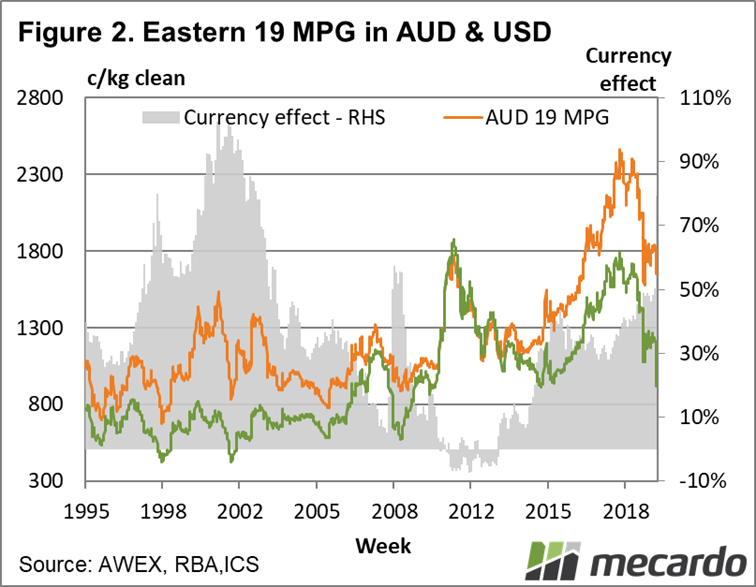Last week the Australian dollar dropped by over 4 cents in one day against the US dollar, a classic reaction to turbulent events around the world. This was the second largest one day fall in the Australian dollar since it was partially floated in the early 1980s. The lower exchange is helping to cushion the down cycle in wool prices seen since 2018.
The relationship between wool prices and the exchange rate is a varied one, far more complex and changeable than a simple negative correlation where wool prices will move in an opposite and complementary way to the currency. Take the past couple of years for example. The wool market has been falling since 2018 peak price levels (with a brief revival in early 2019) and so has the exchange rate (down from mid 70s to high 50s). Keeping this complexity in mind, this article looks at key Merino MPGs in both Australian and US dollar terms.
Figure 1 shows the 17 MPG in both Australian and US dollar terms from the mid-1990s to last week (left hand vertical axis) and the “cushioning effect” of the exchange rate (right hand axis) which is denoted by the shaded area. The “cushioning effect” is the proportional premium/discount of the Australian dollar price to the US dollar price. In 2011-2013 this effect was a discount as the Australian dollar was trading above parity with the US dollar. An interesting aside is that the marketers never seem to adjust for the cushioning effect of the exchange rate when claiming credit for price levels.
The 17 MPG peaked in August 2018 close to 3,000 cents with the Australian to US dollar exchange rate around 73 cents. The 17 MPG last week was down some 39% on the mid-2018 price level while the US dollar value is down a hefty 53%. The weaker exchange rate, finishing last week around 56 cents has done a good job in moderating the fall in price in Australian dollar terms. As Figure 1 shows, the cushioning effect of the exchange rate has been increasing since 2012, as the exchange rate has fallen.
Figure 2 repeats the exercise for the 19 MPG. In US dollar terms the 19 MPG is back to the low levels seen in 2015, the last major cyclical downturn, which was masked for Australian prices by a falling exchange rate increasing its cushioning effect.
The 21 MPG is similarly analysed in Figure 3. The recent 2018 price peak is relatively higher for the 21 MPG than it is for the finer MPGs. Low supply helped push the US dollar price up to 2011 levels, with the lower exchange rate than supercharging the Australian dollar price.
The US dollar prices are showing the real weakness present in wool (and wider apparel fibre markets) currently. The lower exchange rate is helping to support Australian dollar prices at current levels, which don’t reflect weakness in demand when the current prices are compared to prices from the past two decades.
What does it mean?
Even though wool prices have been falling in Australian dollar terms at the same time the exchange rate has been falling, the lower exchange rate is helping soften the extent of the down cycle. The floating exchange rate is “doing its bit”. The low US dollar prices reveal the extent of the cyclical downturn, and history suggests it will take a year or two to work out of the down cycle.Have any questions or comments?
Key Points
- The lower exchange rate is helping to support Australian dollar wool prices; at levels well above most levels of the past two decades.
- In US dollar terms, wool prices have not spent a lot of time below current levels since 2007, so prices are low.
- The story given by the US dollar prices is that wool prices (like most commodities) are in a major down cycle – the thing to remember is that it usually takes some years to work through such down cycles.
Click on graph to expand
Click on graph to expand
Click on graph to expand
Data sources: AWEX | RBA | ICS














